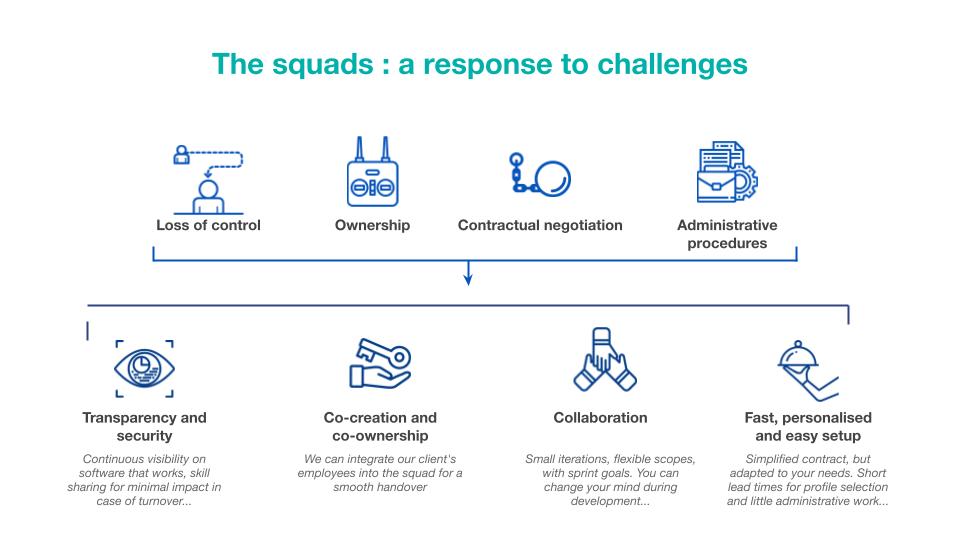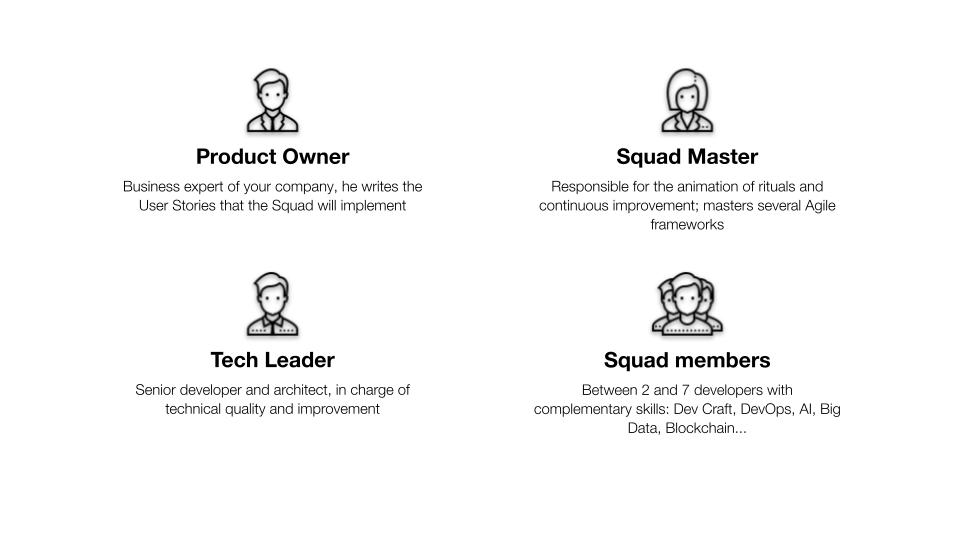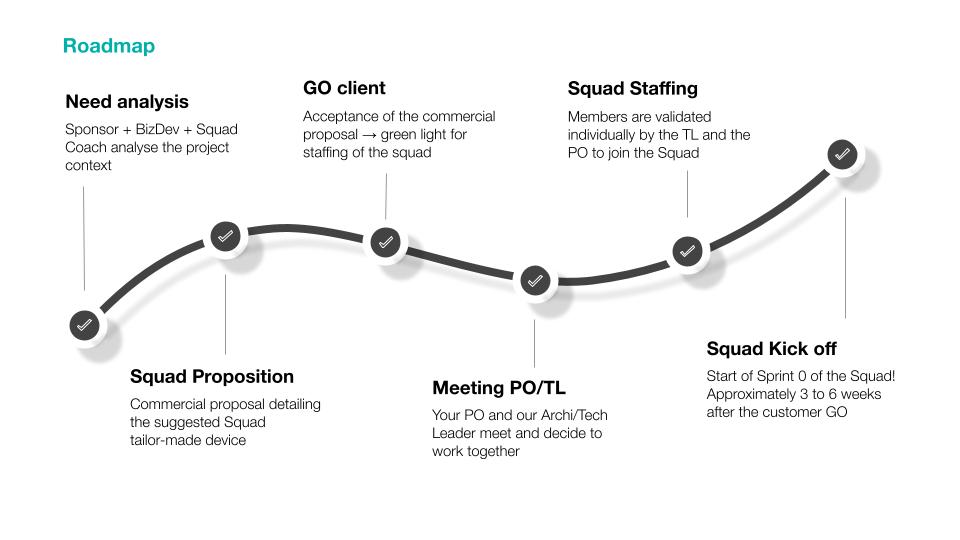If the military term makes you anxious, don’t worry, as the reality is much more cheerful. The word squad here refers to a close team who are armed with the right skills to make your most technical projects come true. Roger that? Let’s focus on the mission.
Borrowed from the military jargon, the word squad describes a battle team smaller than an army, and therefore more flexible as well. As transposed into the business world, a squad is a multidisciplinary team who’s granted autonomy and capable of achieving a project from A to Z. Well used to work in synergy, it also offers more fluidity in your projects’ management, as wells as more product quality thanks to its enhanced efficiency.
1. The Squad Revolution: An Improvement in Technical Project Management
What is a squad?
The appearance of the term squad in the tech industry is quite recent. The origins of such a usage come from an agile project management model developed by the #1 audio streaming company in the world: Spotify. The traded company is indeed considered as a pioneer in agile project management and its larger-scale implementation.
Very early in their history, the company instilled in its core system the creation of squads, meaning teams with diverse skills, shared good practices and led by a Squad Master. The latter will play the role of commander-in-chief, responsible for maintaining the right direction for the project and for the squad to function well in accordance with what the company offers. He’ll also monitor the team, so that everyone feels well and understands the goals. Finally, he also brings information from the ground up to external actors (e.g. the Board or the Commercial Team).

An autonomous and flexible team…
As opposed to an inside project team which would have been created, the squad will act as an autonomous start-up within the company, with members working in collaboration to better serve the needs of the squad. Often made of technical workers (developers, engineers, DevOps,…) or agile profiles (Scrum Master), the squad doesn’t even try to fit into the existing and sometimes complex system of the company, but rather comes with its own agile methods.
The squad’s role is to meet the client’s product needs and to achieve so in the most efficient way possible with maximum added value. It doesn’t fit into the existing tree structure of the company, but rather bring the most appropriate solution to create the best product or service.
A squad is usually composed of several members who occupy distinct but complementary functions: We’ll generally find a Product Owner (PO), who will craft the user stories implemented into the squad; a Squad Master, responsible for ongoing improvement of the product, as well as a tech leader (or Senior Developer) dealing with assuring the quality of the final product. In some cases, the PO and Squad Master can be teamed with agile coaches to support them in the usage of some agile tools and processes.

…who work in synergy for more quality
The main goal for an efficient squad is to make sure good cohesion exists among its members, so that each of them can reach their full potential in synergy, which can be seen on the final product. When a developer is sent to a new client, he’s often obliged to adapt to the company’s pre-existing framework and methodology, which may not be his. A squad will suggest to bring his own work tools and it’ll give
him a common synergy so that he can be more efficient. People using their full technical knowledge and shared good practices will have the effect to produce the code developed by the client in a quicker way.
A win-win relationship appears between the technical team and the client. At Métro, developers became more efficient when they included a squad of 5 developers. Those could indeed bring their own methodologies and more relevant answers to the client’s needs.
This type of management places collaboration back at the centre of the activity, and people management will focus on the team’s well-being while still reaching their goals.
And what about the Squad Master’s role?
The Squad Master must make sure to keep his team’s spirits up as well as maintain a shared vision while still working on ongoing improvements. He must get both his team to function well and the client to be satisfied with the results. He will often question what can be improved or adjusted, and – most important – check constantly for his group to work with a good spirit and its members to be on the same wavelength.
The Squad Master can apply all those precepts with the help from tools taking roots in the agile culture. Those could be retrospectives looking back to what’s been achieved in the latest sprints, or feedback meetings with the client on a regal basis, e.g. every second week. However, the most essential still is to agree on good practices to be able to work on a clean code, which will last through time.
2. The Squad Spirit: Values at the Core of the Project
Splitting work outside silos for more efficiency
On the client’s side, integrating a squad means putting forward innovation instead of working in silos like companies often do. Collaborating with a pre-built team can therefore save much time and gain rapidity in the delivery of a product. We can imagine the case of a bank which would already own several development departments for each of its products: In such a case, when a new product is needed, an all-new developer will come with his vision and will need to adapt it to the bank’s system. With a squad, this new product would be taken in charge by a team of people who can already work together: A concept based on the agile culture and collaborative work which goes in total contrast with often heavy and rigid administration of some companies.
A start-up approach for more innovation and product quality
The squad can be summarized as the embodiment of the agile culture applied to technical project management. It offers developers better working conditions, with more freedom and flexibility, allowing them to create a more qualitative and
innovative service in return. While the client would be tempted to give largesse with the Scrum method, the squad doesn’t even have to convince the client to try it or to show how efficient the agile culture is, it directly implements its own methodology, so that the client can observe the code is clean and working. It will then rely on the external Product Owner to embody the link between the client and technical teams by creating user stories.
By introducing quality into the development approach, an agile squad also assures an ever-constant level of quality. In that perspective, no functionality is delivered if the quality standards aren’t reached, and the agile squad consider the product as finished only when it’s ready for delivery. Developers will start working on the next functionality or user story only after automated tests and integration are achieved, as such a system is applied during the whole development process. Such a way to work diminishes the possibility of technical debt and solves problems related to the software’s quality.
Benefits from externalizing your project team
Not only adopting a squad enhances your productivity and the quality of developed services, but it also allows you to get rid of the heavy processes and budget that an internal recruitment would imply.
Crafted to reach precise requirements from your part, a squad will also avoid you to go through all the integration steps (recruitment, training, costs), so that you can focus solely on the development of your new product and/or service.
No need then to put on the brakes because of the lack of internal expertise or budget for a new developer, the squad will deal with your most particular projects.
Moreover, thanks to its core flexibility, it can integrate change and adapt more easily by proposing shorter delivery cycles, and therefore a quicker transformation.

3. Belonging to the Squad: Alone No More
Stronger together
Working in a squad also comes with a new paradigm for the developer. As he is less isolated within companies he joins, he can therefore work more easily, by enforcing more efficient methods to favor both product quality and innovation. It’s a fact with which François-Eric agrees completely: ‘’The advantage for a developer to work within a squad is to produce more impact and to make things change in a simpler way.’’
In a trustful and more autonomous work environment, the developer can therefore become an actor of change and propose ideas to the client. When an external developer comes in an already established team of developers who have been working together for a long time, it becomes very difficult to make things change. He witnesses wrong practices but doesn’t have enough flexibility to bring real improvements. There’s less questioning with a squad, as it arrives with its own
expertise and organization. The client will explain what it needs and the squad will bring solutions in the most efficient way.
More skills, more quickly, thanks to collaborative work
Such a method also allows developers to enhance their skills more quickly by working directly with more experienced colleagues, and vice versa. At Métro, the squad includes several profiles with very different levels, but who can grow together. The tech leader will gain power in his task, while the less-experienced developer will grow by observing him and still be some help for developers below. If the squad dissolves tomorrow, every member will leave with newly-gained technical and human qualities.
The squad is not only a stimulating work environment focusing on collaborative work, cohesion, and mutual learning, but also a state of mind in which everyone is capable of adapting and working together, as the technical level comes last.
The only question left is: Are you down for it?












